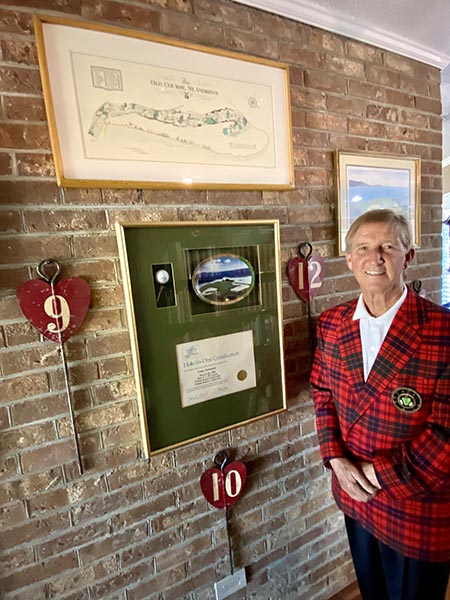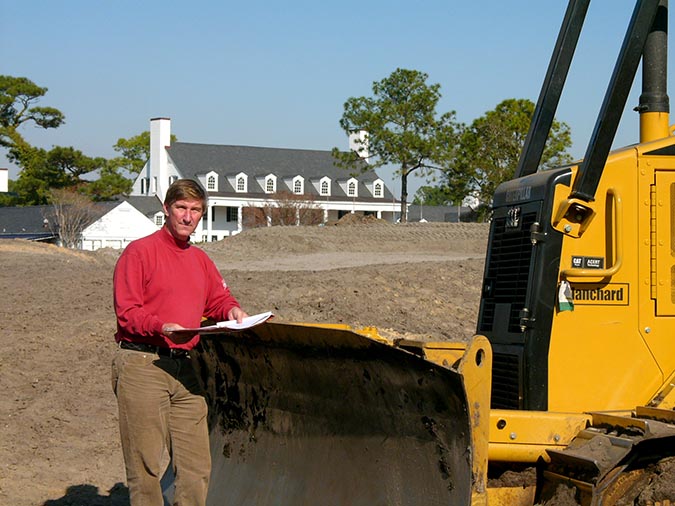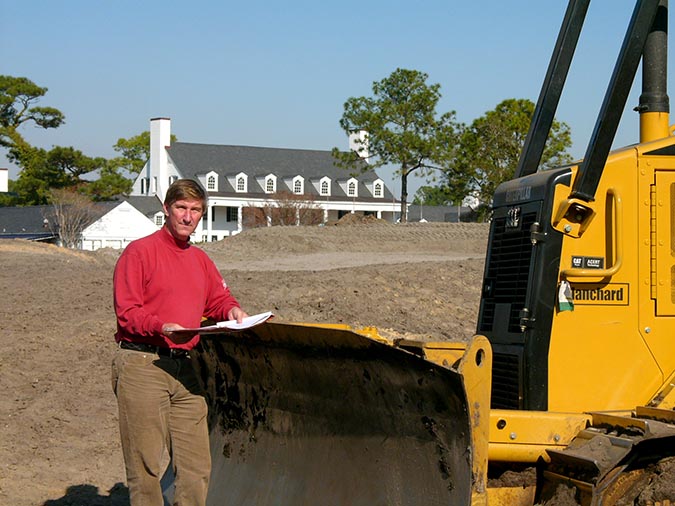Craig Schreiner

“I met a landscape architect who worked for the contractor as well, and since I loved the golf environment completely, it inspired me to get a degree in landscape architecture.”
– Craig Schreiner
March 2021
By Sally J. Sportsman
Golf course architecture has a special allure. Sketching imaginary holes on paper napkins is a common indulgence among amateur players everywhere. For some, the desire to become a golf course designer becomes a genuine pursuit, evolving into a lifelong passion and profession. This certainly was true for longtime GHS member Craig Schreiner, ASGCA, ASLA.
Growing up in the Midwest, Schreiner had the good fortune of being immersed in golf from a young age. Once he decided on golf course design as s career, his education came in the form of intensive study, wide travel and exposure to some of the best in the business. Today, as an accomplished architect with numerous renovations and original designs to his credit, he also has become a serious collector of books on golf history and course design.
In this interview Schreiner reflects on his journey and his lifetime of learning about the game – and the thrills it never ceases to provide.
Where were you born, and where did you grow up? When did you move to Myrtle Beach, South Carolina?
I was born in Kansas City, Missouri, in 1952. I grew up in Akron, Ohio, and moved to Myrtle Beach in 2006.
How were you first introduced to golf, and when did you realize it would be important to you?
My father took me to a par-three course in Akron along with my brothers and taught us the basics. I loved the setting and the greenery, the manicured look, and the game, which allowed me to hit the ball without someone throwing it at me, requiring me to dribble, or tackling me! I could play it alone, as well.
Why did you decide to become a golf course designer?
I worked as a locker room attendant at the Fairlawn Country Club in Akron, shining shoes, caddying and waxing members’ cars. When I turned 16 and could drive, I began working for a member who had a very large landscape contracting firm and who worked on a private men’s course that George Cobb designed in Sharon Center, Ohio. I met a landscape architect who worked for the contractor as well, and since I loved the golf environment completely, it inspired me to get a degree in landscape architecture.
What is your educational background?
I studied culture, climate, ecology and the built environment in over 20 countries while in college at Oregon State University. My education exposed me to the most dramatic built environments and how to integrate our cultural and economic needs with nature. Comparisons were made of ancient civilizations like that of the Inca City Machu Picchu in Peru, with new towns in Great Britain, Europe and Scandinavia. Edinburgh and St Andrews were on the itinerary of one of the trips to study post-WWII construction of new towns adjacent to older cities. Once I graduated with my BS degree, I earned my Landscape Architecture credentials and then attended Ohio State University’s Agricultural Technical Institute in Wooster to study turfgrass science, which included an internship at the Baltimore CC at Five Farms. That in turn led to a National Academic Scholarship from the GCSAA (Golf Course Superintendents Association of America) and another from the Ohio Turfgrass Foundation. Most importantly, the Wadsworth Golf Construction Company afforded me the opportunity to participate in the construction of Valhalla Golf Club, in Shelbyville, Ky., and the first course at Barton Creek, outside Austin. Both were premier courses, designed by Jack Nicklaus and Tom Fazio, respectively.
Describe how you got to know Tom Watson and your professional relationship with him.
I was interviewing with Tom Watson after the president of Wadsworth Golf Construction recommended me to Tom as a designer. The interview was a great experience, but they were looking for someone with different long-term aspirations. He was very complimentary of a public course I did in Hamel, Minn., while working as the design coordinator for Michael Hurdzan. Tom was impressed by the fact that an 18-hole course was built for the same price as the first hole at Devil’s Pulpit, another course the Hurdzan firm was working on, in Caledon, Ontario. A few years later, I was involved in the design of a First Tee facility at Sunflower Hills, paid for by a Kansas City golf charity that Tom had been actively involved in for years. He was at the dedication with a great crowd of inner-city kids who were to be the benefactors of this charitable collaboration. Since then, Tom became a Member of the American Society of Golf Course Architects (ASGCA). Several years earlier, in 1989, I was inducted into ASGCA, the same year as Jack Nicklaus.
Who are some golf course designers of the past whom you admire, and why? How did they influence you?
Jack Kidwell, PGA, ASGCA, who was one of Mike Hurdzan’s mentors, was probably my favorite. He could do more with less money than any architect I know, without compromising the design, playing quality or the course maintenance regime. Working with him taught me that money alone does not make a good golf course. Routing the course, understanding soil science, integrating drainage and “functional” shaping that diverted water run-off were the basics. Adequate construction budgets and designs that promoted efficient maintenance were the keys to economic sustainability without which environmental sustainability cannot be possible. A golf course had to be simple with interesting, beautiful greens and minimal bunkering. Distance and topography can add all the challenge you need versus multiple hazards. He insisted that simplicity was the key to longevity and viability in a golf course.
Kidwell admired the work of Dr. Alister Mackenzie, as do I, because he also emphasized the need for practicality. Mackenzie was fortunate to work on some of the most dramatic sites in golf. However, he learned his basics from the most ‘organic’ course in the world, The Links at St Andrews, Scotland. Seashore ecology is the most dynamic of any environment on earth. ‘The Links’ at St Andrews were being formed long before the Roman Empire was built! Old Tom Morris simply ‘linked’ the work of nature with living quilts from the Family Poaceae, Genus Agrostis and the wool-bearing animals of Scotland, keeping the verdant cut tightly.
Which of your design projects are you most proud of and why?

Renovation of the South Course greens at Firestone Country Club (FCC), Akron, Ohio. The project was a refinement and enhancement of the 18 putting surfaces re-designed earlier by Jack Nicklaus. My job was to soften the slopes of critical tournament hole locations and divert water run-off from gallery mounds into smaller basins to keep it off the greens. The work was tedious, as each surface was topographically surveyed, measured in tenths of feet and then re-contoured to produce challenging hole locations for the NEC & Bridgestone World Tour Events. Surface water was diverted into smaller drainage areas and some into new basins located around the back and side portions of the greens. The shapes of 12 greens were preserved with new hole locations added on the perimeters of greens 2, 7, 9, 12, 13 and 17. My final responsibility was to finish grading each putting surface to ensure that final pin locations would be fair at Stimpmeter readings of 12 or higher. Since those improvements and modifications were implemented back in the early 90s, Tiger Woods set a PGA Tour record of seven wins at the course. Dustin Johnson, Rory Mcllroy, Adam Scott, Vijay Singh and Justin Thomas have won there, too! My father, Charles, was a member at FCC in the 50s and 60s as an employee of Firestone Tire & Rubber, and my younger brother, Denny, a retired broadcast announcer for ESPN and Golf Channel, was a club champion as a member. This is hallowed ground for me.
The opportunity came to me via a recommendation from Denny to FCC Manager Don Padgett, PGA, based on work I had just finished at Oak Hill CC’s East Course in Rochester, N.Y., in preparation for the 1995 Ryder Cup. My tasks at Oak Hill were to restore the green shapes and reclaim original hole locations on the East Course, designed by one of our founding members, Donald Ross, ASCGA, of Dornoch, Scotland. The U.S. lost that year when Irish rookie Philip Walton drained a tough putt on 18, where I was watching from inside the ropes. My father and I were guests of Oak Hill throughout the matches and he was so proud of my work at such an early time in my career. Golf had finally taught me things he had tried to teach me for many years!
Working with two other PGA Tour Professionals has been a great experience, as well. Masters Champions Larry Mize and Nick Price are wonderful people, genuine in every way and good family men. I have collaborated with them on renovations and new courses, respectively. Larry Mize consulted on a renovation at Maple Ridge GC in Columbus, Georgia, as well as on a new practice facility for the Columbus State University golf team, with guidance from Cougars coach and CBS Broadcaster Mark Immelman.
My home course, Grande Dunes Members Club, was a design collaboration with PGA Tour Hall of Fame member Nick Price. Nick had meaningful input on each green concept regarding strategic hole locations. He added refinements to the 9th and 18th holes, making each exciting to play. He was emphatic about keeping the course open and friendly, based on his post-tournament outing experiences with high-handicap golfers. The short-game area was another spot he spent time with me on to refine the practice component and make it interesting.
I am still busy design/building practice facilities with putting and chipping greens. The most recent is at the DeBordieu Golf Club and before that, the Dustin Johnson Golf School in Myrtle Beach, for Allen Terrell.
This summer I will be engaged in shaping 11 new greens and 63 bunkers at the John’s Island Club, in Indian River Shores, Fla. It is my most revered client and the oldest working relationship (24 years) I have had in my 33-year career. The North Course was the first one I worked on, 20 years ago. The South Course was fully renovated three years ago. Both courses were Pete Dye designs with collaboration from Alice. My endeavor has been to further enhance the original Dye designs with drainage and playing improvements, based on membership recommendations and staff input. The North Course will mark the second renovation and one that I am looking forward to with great anticipation.
What are some of your philanthropic interests?
I have been actively involved in First Tee by designing three facilities: Sunflower Hills with Tom Watson, another one for the City of Akron called Mud Run and a third in Baton Rouge for the BREC called Clark Park. Golf is in need of introductory facilities for anyone who is interested. First Tee has been a good start for many young and less fortunate people. At the grand opening of First Tee – Akron, Ohio’s Mud Run, Ben Curtis, PGA Tour, winner of the The Open in 2003, birdied the first hole. My favorite thing to say to all who will listen: “Get off the phone and swing a club.” That includes me!
Finally, giving back is important to spiritual development. Golf has provided me with rich experiences and a good living that I still can’t believe is happening.
Describe one of your favorite golf memories.
My first meeting of the ASGCA was at Pebble Beach. I was inducted alongside one of my golfing heroes, the legendary Jack Nicklaus, who had offered me a position in his international golf design company just weeks before. I decided to decline the offer and start my own practice. I remember what he said to me when we met again the morning of our first meeting with the ASGCA: “Good luck and keep in touch.” Later that day I aced the infamous 7th at Pebble Beach in my first ASGCA tournament. That night at Pebble Beach CC during the Donald Ross banquet, Jack congratulated me on my “perfect shot” on the 7th and I think he remarked that he missed the green on the 7th during the howling conditions of his final round of the 1972 U.S. Open Championship win. I took this golf experience as a good omen to continue on in my endeavor to practice golf course architecture on my own. I haven’t regretted declining Jack’s offer of employment in 33 years. My brothers still think I was crazy not to work with Mr. Nicklaus. Honestly, some days, I do, too.
My photo for this profile was taken at the entrance to my office-library in front of the “Wall of Fame” where I have documented my most famous hole-in-one at Pebble Beach, underneath the Old Course, St Andrews, delineated by A. MacKenzie in March of 1924.
What has the game meant to you over the years?
Golf is best described in elaborate form by Theodore Arnold Haultain in his 1908 spiritual dissertation, The Mystery of Golf. It is the finest book I have every read on the subject of golf, PERIOD!
The opening paragraph says it all… “Three things are as unfathomable as they are fascinating to the masculine mind: metaphysic; golf; and the feminine heart. The Germans, I believe, pretend to have solved some of the riddles of the first, and the French to have unraveled some of the intricacies of the last; will someone tell us wherein lies the extraordinary fascination of golf?”
The mental factors of golf are the most interesting to me. That’s why I love Haultain’s book. I was mentally lazy as a child and it took its toll on my personal development. Born with endless enthusiasm that was not harnessed until my late 20s, it was golf that opened the door to my mental and personal development. Masters champion Herman Keiser, PGA, would smack my left knee with his golf club to get me to rotate my lower body during my first lesson with him. Humility was golf’s first and most important lesson! ASK FOR HELP!
To succeed, golf requires both physical and mental discipline. Open-mindedness is another key element. Ego-deflation will always provide a smoother round of golf, regardless of the score. Temperament is an individual battle that must be won if you are to enjoy golf. The basic principles that golf requires in order to succeed helped me develop into a professional designer, husband, family member and citizen. Honesty, respect, confidence, personal responsibility, perseverance and courtesy are essentials to good golf and good living. It wasn’t until I realized that cheating at golf, when playing alone, won’t get you far in life. Fascinating!
What is one facet of golf history that fascinates you?
Golf’s history is recorded in so many ways. Books, books and more books. My library consists of over 3,000 books of varying interest. Golf course architecture and agronomy are my favorites. However, Haultain and Mathison works are so perennial to my reading list. Each time I read them I learn something new about myself. Books written about golf hundreds of years ago still teach me things about myself today that resonate and help me lead a better life. A 30-foot putt that drops or a shot that rides the wind perfectly onto the green pin high is exhilarating. Witnessing a great shot hit by my wife or a professional golfer makes me happy. Catching myself getting too serious about the game has led to some humble pie desserts I didn’t want.
How did you learn about the GHS? When did you join?
I was a member of the Golf Collectors Society starting back in the 1980s upon advice from Alistair Johnston, and have maintained my membership for over 30 years. I have books from the personal libraries of Murdoch, Kuntz and Hurdzan, which I treasure. My design office in Myrtle Beach is an addition to our home that combines the library with my office, where I design and renovate golf courses. It is a beautiful space that I designed which includes views into my garden that hosts over 25 species of birds throughout the year.
What kinds of golf memorabilia interest you?
Mike Hurdzan introduced me to golf’s illustrious written history and other artifacts, such as original course drawings, clubs, balls, art and ceramics at his home in the late 80s when I was the design coordinator of his firm. All of these I have collected to some degree, but books on architecture interest me most. I have a comprehensive list in this category and favor anything regarding putting greens. The putting surface is the ‘heart of every hole’ and I threatened to write a book with such a name, but not as of yet.
Why do you enjoy being a GHS member?
The GHS has been a “step up” with all due respect to the old Golf Collector’s Society Bulletin and I love the “Journal” (The Golf). The quality is “collectable” and educational. It has a similar flavor of old but looks much nicer with a more comprehensive global reach into the past and present. This particular piece may not add much to the GHS’s rich content, but I have enjoyed looking back into my career to answer your questions. The Golf Heritage Society has a fabulous membership and I look forward to each volume of The Golf because it is illuminating, entertaining and informative.

